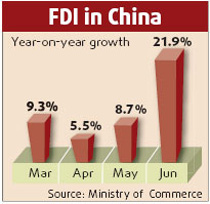China will soon open its own Nasdaq-like growth board, providing a boon to Chinese start-up companies.
Getting finance used to be a big headache for Chinese start-up companies.
But the difficulties will soon ease with the expected debut of a Nasdaq-like growth board this year.
The China Securities Regulatory Commission's chairman Shang Fulin said China's growth board would help establish a multi-layer capital market.
Small- and medium-sized companies have been anticipating the establishment of such a board for some time, and are expected to be delighted by the development.
Back in 2000 when the Shenzhen Stock Exchange applied to establish the Small- and Medium-sized Enterprise Board to facilitate the growth of start-up companies, people expected a platform similar to the Nasdaq which connected bright but money-tight companies with investors who wanted to make a bet.
However, when the Shenzhen board started in 2004, the threshold to get listed was not as low as expected.
It required a company to be profitable for three consecutive years, generate at least 30 million yuan (US$4.1 million) in collective earnings during the three years and have cumulative revenue during that period of 300 million yuan - almost the same criteria as the one for the main board.
"It is not what people expected," said Zhang Qi, an analyst with Haitong Securities Co.
"The board does not fill the role as a platform to assist start-up companies."
Zhang said the reasons behind the Shenzhen board's threshold requirements included the bad performance of high-tech companies in those days and the failures of a few boards of a similar nature in foreign markets.
But the impact at the time of restricting easy access to finance meant some companies shifted to the main board for funds, some struggled to survive, some went to the illegal underground banks and some others simply disappeared.
"The current system does not serve the demand of these companies," said Zhang.
"They need money and may provide a handsome return."
"But the potential risks make the policy makers reject their need," he said.
The situation is now changing.
By the end of last year, the Shanghai Stock Market reported transactions worth 37 trillion yuan, more than triple the figure a year earlier.
The smaller Shenzhen Stock Exchange's market value also reached 5.54 trillion yuan.
Moreover, China has been beefing up efforts to diversify products - the regulator is preparing for the launch of a stock index futures, which allows investors to sell short for the first time on the mainland.
Shang Fulin noted the long-awaited growth board was now seen as a logical and necessary step.
"We will push forward the debut of China's growth board to establish a multi-layer capital market," Shang said.
"It is the demand to support the national strategy of encouraging self-developed innovation and steer the economy from labor and resource-intensive industries."
The draft rules for the growth board are also expected to significantly encourage start-up companies.
The two-year earnings requirement will be cut to 10 million yuan and the daily trading limit for the growth board will be expanded to 20 percent, compared with 10 percent for regular shares traded on the main board.
"The growth board is set to be an active market, producing numerous opportunities but risks as well," said Sun Lijian, a finance professor at Fudan University.
Similar boards in some foreign markets that have run into problems would provide valuable lessons for the Chinese, he said.
The Nasdaq Stock Market is among only a few ultra successful boards for smaller companies.
Last year, Nasdaq became the largest United States exchange by processing 29 percent of all equity trades by December, up from 27 percent in 2006.
"The key to Nasdaq's success and growth comes down to three simple words: volume, volume and volume," said Sun.
"The United States has a deep-rooted tradition to support small tech-related companies with high growth potential."
A dozen Chinese companies, including Sina Corp, Baidu.com Inc, and Focus Media, picked Nasdaq as their base for the board's global reputation.
Other boards, such as the Alternative Investment Market in London's Stock Exchange and Growth Enterprise Market in Hong Kong's Stock Exchange, were more lackluster.
Regulators in Hong Kong are even considering a plan to reshape its Growth Enterprise Market, which did not attract a single new company to sell shares on it last year and only six companies chose it to make their initial public offerings in 2006.
"The deciding issue is to design rules both to take risks under control and to make it attractive enough for small and medium-sized companies," said Sun.
Key elements in the draft rules for the growth board
The company should operate for at least three consecutive years with a clear-cut core business.
The company's two-year earnings should exceed 10 million yuan (US$1.43 million).
The company's most recent yearly revenue should exceed 30 million yuan and should increase no less than 30 percent from a year earlier.
The company's core business should generate earnings no less than half of total revenue.
The daily trading limit will be 20 percent.
(Shanghai Daily February 18, 2008)


